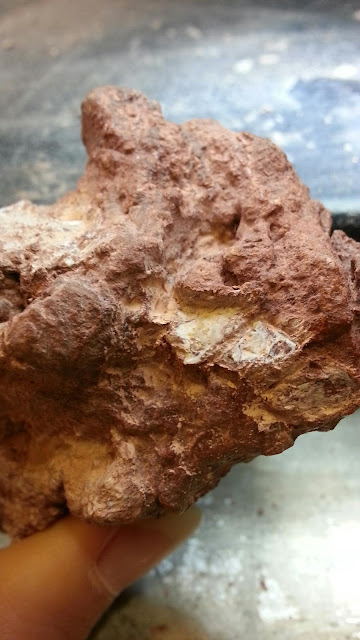Since I need David's help with the Jane jacket I've been working on, I decided to do some air scribe work on Jane’s leg bone. The first day in the lab I was there for 3 hours and had no issues, but by the second day the air scribe needed to be cleaned. I spent most of my 2.5 hours there doing this. As you can see in the pictures below I had to take the tool apart and clean all the pieces with q-tips. Once I got all the blackened oil off, I had to re-oil the air scribe using more q-tips. Cleaning the machine resulted in a much clearer sound, which is how I knew that the cleaning helped. I also cleaned a small piece of one of Jane’s bones that was found with her leg bone. It was really cool to see the white of the bone show through from under the caliche.
Saturday, December 19, 2015
Saturday, November 21, 2015
Removing Vinac and Dirt
My work in the lab was slow the past two weeks, because I was slowly removing dirt and vinac from the small Jane jacket. I spent 3 hours in the lab both weeks. The vinac was originally used to glue some of the bones together and keep them in place while I was removing dirt from the jacket. The only issue with this was that some of the vinac had gotten on the dirt and was holding it in place. I had to add a lot of water, which helped to dissolve the vinac. I was then able to scrape away a bunch of dirt that was previously stuck inside the jacket. It was very satisfying to see a large clump of dirt being slowly cleared away. I am now to the point that I will probably need David’s help to remove a layer of bone before I can do much more with this jacket.
Saturday, November 7, 2015
A Box of Sea Treasures
The first week I just worked on the small Jane jacket for 3.5 hours. Last week I was in the lab for 3 hours and started removing dirt from the small Jane jacket. A little while into working on this David came into the lab and showed me a really cool box of fossilized pieces of ocean life. These included stingray teeth, shark teeth, fish vertebrae, eel vertebrae, and stingray barbs. I got to dig through these as I filled small plastic bags with about an ounce of goodies. I enjoyed getting to look at fossils that I hadn't seen before and trying to identify them. My favorite fossils were the teeth because there were so many different types. There were also a few that had a very similar shape to Dimetrodon teeth, which I found particularly interesting because Dimetrodons were part of some of the first land ecosystems during the early Permian period.
Sunday, October 25, 2015
Another Piece of Jane
On week one I went to the museum for one and a half hours, and after missing a week I spent three hours in the lab during week two.
Since I was not in the lab for too long on the first week I decided to clean another small piece on bone from Jane that was found near the leg bone that I have been cleaning. For this I used a straight pick instead of an air scribe, which I have not used much because usually the caliche on Jane's bones is a little to thick for it. While the air scribe may have been faster I enjoyed practicing using a tool that I do not get to use all that often. I was very happy with how well the caliche cleaned off of this piece.
During the second week I continued to use the air scribe on Jane's leg bone, and I was able to clean off more bone from both the back and front.
Monday, October 5, 2015
The Intern Gets an Intern
On week one I spent four hours in the lab. During this time, I worked on removing caliche from the underside of the pice of Jane's leg bone I've been working on. It took a while for me to get through the caliche and actually reach bone. This was due to the thick layer of caliche and the fact that I didn't know where there was bone and where there wasn't. Needless to say it was a very slow, but rewarding, process. Once I reached the bone I spent the rest of my time in the lab slowly removing caliche outwards until I had made a decent hole in it. In order to better see the bone I dipped a q-tip in water and used it to remove the remaining dirt. That was a very rewarding moment because I finally had a really good view of the bone I had been working on exposing for four hours.
During week two I spent three hours at the museum. Ian came with me, like normal, but since he had finished his scientific illustration the week before and David was out of town I got to show him what I do. I had him organize bits of bone from the spoil pile to try and get an idea of what everything was. While he did that I worked on removing more caliche from the front of Jane's leg bone with the air scribe. Then I got the explain to him what all the things from the spoil pile actually were and how they fit together, or didn't. Finally I taught him how to used the air scribe and helped him to try it on a bit of spoil bone. He did a really good job, and told me he had a new appreciation for what I do in the lab.
Subscribe to:
Posts (Atom)





























































